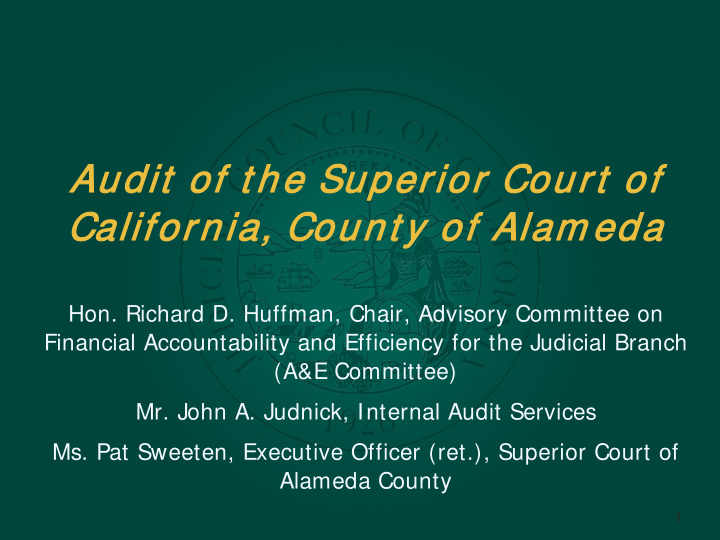



Audit of t he Superi rior r Court rt of Cal alifornia, Count y of Alam eda Hon. Richard D. Huffman, Chair, Advisory Committee on Financial Accountability and Efficiency for the Judicial Branch (A&E Committee) Mr. John A. Judnick, Internal Audit Services Ms. Pat Sweeten, Executive Officer (ret.), Superior Court of Alameda County 1
A&E Committee Duties regarding audit reports: • Review all audit reports for the Judicial Branch. • Where appropriate, make recommendations on individual or systemic issues for the Judicial Council’s consideration at the time it receives and considers audit reports. 2
A&E Committee See A&E Committee comments on page 2 of the Judicial Council report. • A&E Committee is presenting for discussion one specific issue identified in the audit report of Alameda Superior Court. • Presentation should not be considered a ‘criticism of the Court’ but a ‘lessons learned’ for the benefit of other courts. Issue 6.1 starting on pg. 28 of audit report. 3
A&E Committee Existence of technical industry guidelines and State requirements necessary to comply with an information technology (IT) project. Superior courts are not required to comply with the State • requirements concerning an IT project at this time. (Refer to GC 68511.9 for projects over $5M on next slide.) Industry guidelines and standards should be followed for • proper management and control of an IT project. 4
Guidelines, Standards and Requirements Many courts are probably unaware of the specialized guidelines, standards, and requirements. • Notice and informational/documentation requirement under Government Code section 68511.9 for all administrative and infrastructure information technology projects of the Council or the courts with total costs estimated at more than $5 million. 5
Guidelines, Standards and Requirements Project management standards (“PMBOK”) issued by the • Project Management Institute. Standard system development life cycle (SDLC) standards • and guidelines : Institute of Electrical and Electronics Engineers, Inc. (IEEE) • 15288-2004 - IEEE Standard for Systems engineering -- System life cycle • processes 1012-2012 - IEEE Standard for System and Software Verification and Validation • State Department of Finance (DOF) • Information Technology Project Oversight Framework • The California Technology Agency (CTA) • Project Management Methodology Reference Manual • 6
5 Basic Stages in a SDLC 1. Concept • Define need • Produce a Concept Statement • Supporting documentation: Feasibility study (FSR) and cost estimates (EAW) • Costs estimates include all costs associated with the project including estimates of internal court and justice partner costs Alameda Court issues – page 30 of audit report 7
5 Basic Stages in a SDLC 2. Project Initiation Authorize and define the scope of the project. • Defines business case, purpose and business objectives • Project Charter is major output • Verification and validation analysis / determination / • acquisition Determine if any conflicts of interest exist and document • results. Alameda Court issues – pages 30 to 33 of audit report 8
5 Basic Stages in a SDLC 3. Project Planning Define and mature the project scope, develop the project • management plan, identify and schedule project activities. Project Management Plan is major output document. • Governance and mgmt. framework • Oversight needs • Alameda Court issues – page 33 of audit report 9
5 Basic Stages in a SDLC 4. Project Execution Complete work as defined in the Project Management Plan. • Output of this stage - agreed upon deliverables and • performance data reports. Alameda Court issues – pages 33 - 34 of audit report 10
5 Basic Stages in a SDLC Closing 5. Formally terminate all activities, put into production or • active status. Prepare a Post Implementation Evaluation Report • (PIER). Lessons learned report. Alameda Court issues – page 34 of audit report 11
Lessons Learned MS. PAT SWEETEN, EXECUTIVE OFFICER (RET.), SUPERIOR COURT OF ALAMEDA COUNTY 12
THANK YOU QUESTIONS ? 13
Recommend
More recommend